Kangaroos are iconic marsupials native to Australia, known for their distinctive hopping gait and powerful hind legs. They inhabit a variety of habitats across the continent, from grasslands and woodlands to deserts and scrubland. Despite their impressive size and strength, kangaroos are not invincible in the wild. Like all animals, they face predators that threaten their survival.
The natural world is full of carnivores that prey on other animals for food. Some predator-prey relationships have been established over millennia, while others have emerged more recently due to changes in habitat or human intervention.
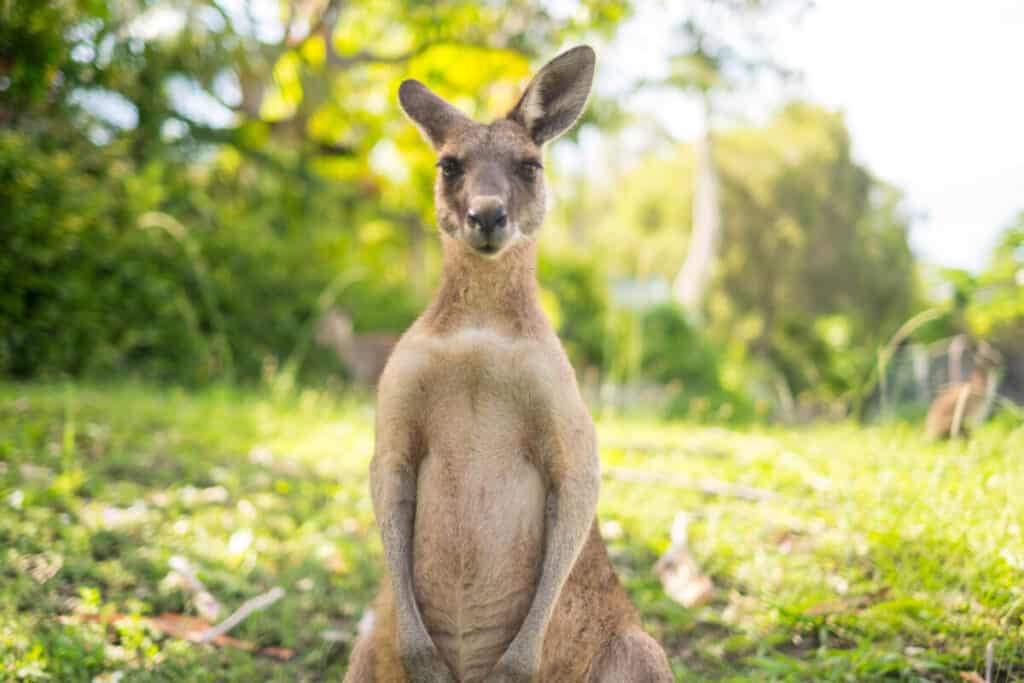
Carnivores Of The Australian Outback
Predators are an integral part of the Australian ecosystem, and they play a significant role in regulating populations of prey species, including kangaroos.
The carnivores that inhabit the Australian outback have adapted to survive in this harsh environment, where resources can be scarce and competition for food is high.
One of the most iconic predators found in Australia is the dingo. This wild dog roams throughout much of the continent, preying on a variety of animals, including kangaroos. Dingoes hunt alone or in packs, using their keen senses to track down their quarry.
Another important predator in the Australian outback is the wedge-tailed eagle. These birds are opportunistic hunters that will take advantage of any available food source, including kangaroo carrion. They are also known to attack live prey, swooping down from above at great speeds to capture unsuspecting animals.
Australia’s unique collection of predators demonstrates just how finely tuned its ecosystems are. Each animal has evolved specific adaptations that allow them to thrive in this unforgiving landscape.
As such, it is crucial that we respect these ecological relationships and ensure that they remain intact for generations to come.
Top Kangaroo Predators
The Australian Outback is home to a wide variety of carnivores, all with unique hunting habits and prey selection. Like in any ecosystem, the predator-prey relationship plays an important role in maintaining balance. It’s fascinating to observe how each animal has adapted to its environment and developed specialized skills for survival.
Among these predators are some of the top kangaroo hunters on the continent. Kangaroos have evolved to be fast runners and powerful kickers, making them difficult prey for many animals. However, there are several species that have found ways to successfully hunt them down. These predators include:
- Dingoes: Wild dogs that hunt in packs
- Tasmanian devils: Carnivorous marsupials known for their ferocity
- Wedge-tailed eagles: Large birds of prey with impressive wingspans
- Saltwater crocodiles: Massive reptiles that can weigh over 1,000 pounds
Each of these animals employs different strategies when it comes to hunting kangaroos. For example, dingoes work together as a team to surround and tire out their prey before going in for the kill. Tasmanian devils use their strong jaws to latch onto a kangaroo’s neck or throat and suffocate it. Wedge-tailed eagles swoop down from above and grab kangaroos with their talons, while saltwater crocodiles wait near water sources where kangaroos come to drink.
Overall, studying the hunting habits and prey selection of these predators provides valuable insight into the complex relationships within ecosystems such as the Australian Outback.
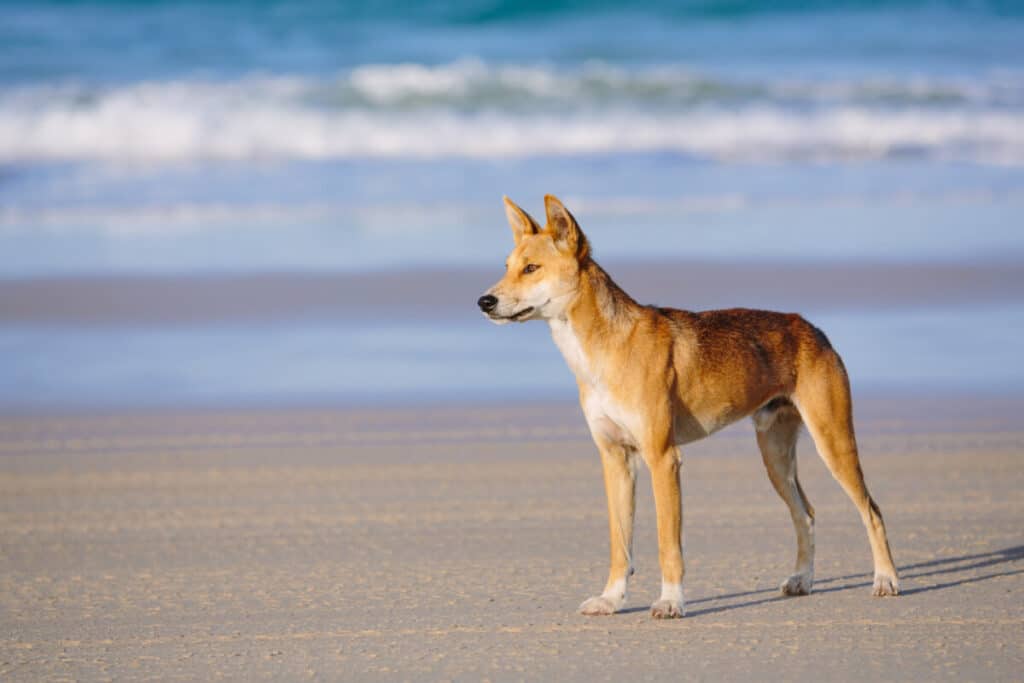
Dingo – The Wild Dog Of Australia
The dingo, also known as the wild dog of Australia, is a predator that preys on a variety of animals, including kangaroos. Dingoes are skilled hunters and have been observed using cooperative hunting strategies to take down larger prey such as kangaroos. They often hunt in packs and use their sharp teeth and strong jaws to kill their prey quickly.
Despite being considered pests by some farmers due to their predation on livestock, dingoes play an important role in maintaining ecosystem balance in Australia. However, there are concerns about the impacts of human activities on dingo populations and their habitats.
Conservation efforts aim to protect these native predators from threats such as habitat loss, hunting, and poisoning. These efforts involve research into dingo behavior, population monitoring, and education programs aimed at promoting coexistence between humans and dingoes while minimizing conflicts with farmers.
Overall, protecting dingoes is essential for preserving Australia’s unique biodiversity and ecological systems.
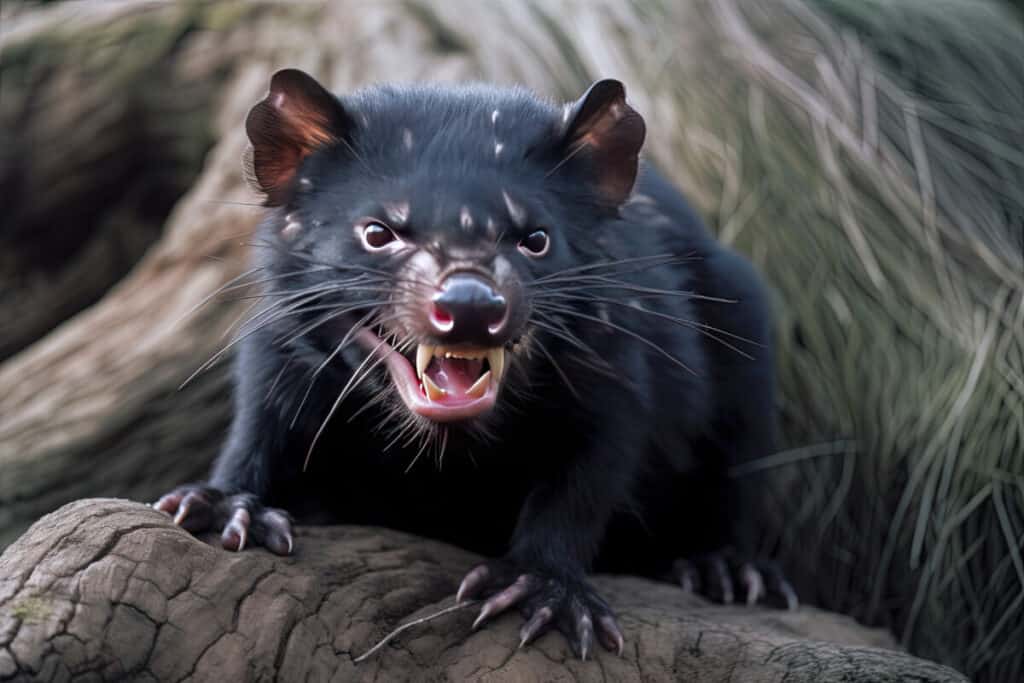
The Mighty Tasmanian Devil
The Tasmanian devil, also known as Sarcophilus harrisii, is a carnivorous marsupial native to the island of Tasmania in Australia. These creatures are typically nocturnal and solitary hunters that feed on a wide range of prey, including small mammals, birds, reptiles, insects and carrion.
Although they will not feed on healthy, adult kangaroos, they will prey on weak or the young.
In terms of reproduction habits, female Tasmanian devils have an interesting way of selecting their mate. Females will mate with multiple males within a short period of time before giving birth to several young at once. This process is called polyandry and it allows for genetic diversity within the offspring.
Despite being ferocious predators, Tasmanian devils are now facing endangerment due to habitat loss and disease outbreaks such as Devil Facial Tumor Disease (DFTD). The conservation efforts aimed towards these animals include captive breeding programs and research into developing vaccines against DFTD.
As for diet preferences, Tasmanian devils are opportunistic eaters and will consume just about anything they can catch or scavenge. Their strong jaws allow them to crunch through even the toughest bones in order to extract every last bit of nutrition from their meals. In addition to providing food for themselves, they also play an important role in maintaining the balance of their ecosystem by controlling populations of smaller prey species.
Overall, despite their fearsome reputation as predators, Tasmanian devils remain essential components of the Australian wilderness and warrant our continued attention and protection.
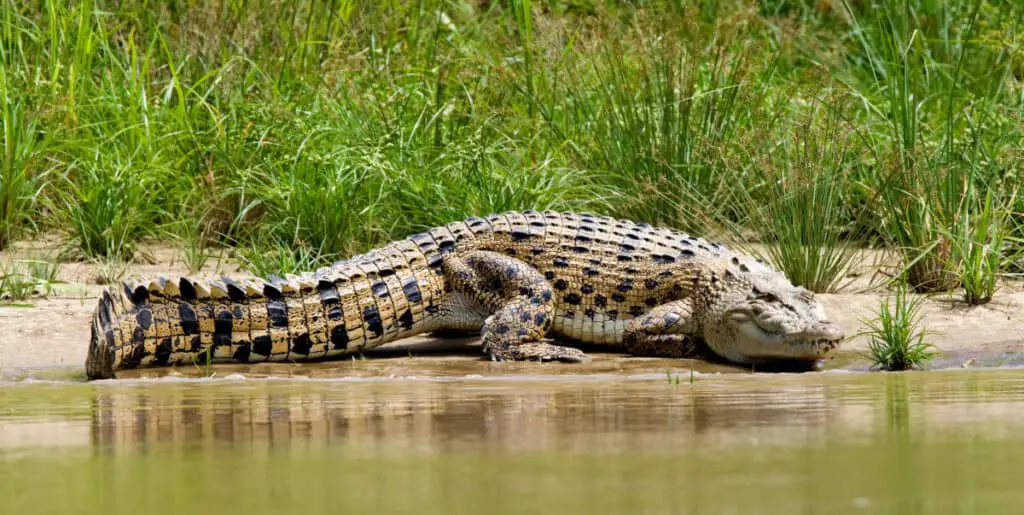
Crocodiles – The Ambush Predators
It may come as no surprise that crocodiles, the giant reptiles known for their prehistoric look and lazy riverside basking habits, are some of the most efficient predators in Australia. They possess remarkable hunting techniques that have helped them survive for millions of years.
Crocodiles are ambush predators, meaning they wait patiently near water sources to catch their prey off-guard. When a kangaroo comes down for a drink or to graze near the riverbank, it becomes vulnerable to an attack from below. With lightning speed, the crocodile lunges out of the water with its powerful jaws open wide enough to swallow small animals whole.
The impact of crocodile predation on kangaroo populations is not well understood; however, researchers speculate that it could be significant in certain areas where both species coexist.
In addition to being agile hunters, adult saltwater crocodiles can grow up to 7 meters long and weigh over 1 tonne! Their sheer size alone makes them formidable opponents against anything that crosses their path. To further emphasize this point:
- Saltwater crocodiles are believed to be responsible for more human fatalities than any other animal in Australia.
- These apex predators play an important role in ecosystem balance by controlling herbivore numbers.
- Kangaroos use rivers less frequently when there is a high risk of encountering crocodiles.
- Wetland habitats critical to sustaining native wildlife populations are threatened by habitat loss and degradation caused by human activities such as land clearing and pollution.
In conclusion, despite their slow-moving demeanor on land and seemingly docile behavior at first glance, crocodiles should never be underestimated as hunters. Their unique set of hunting skills has allowed them to thrive in Australia’s vast wetlands and river systems for millennia while impacting kangaroo populations through various ecological factors.
It is essential that we continue studying these fascinating creatures so that we can better understand their behavior and role in the ecosystem.
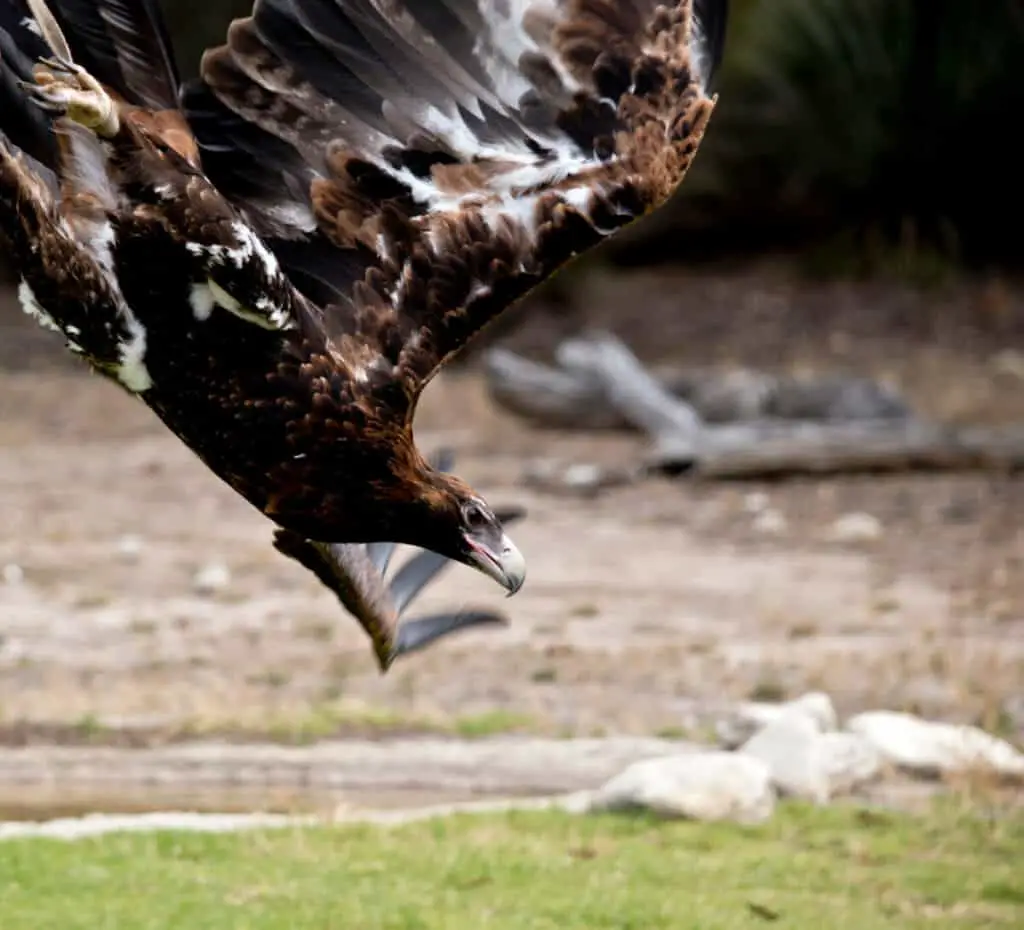
Birds Of Prey – The Aerial Hunters
Birds of Prey have been observed preying on kangaroos. These aerial hunters have impressive eyesight and can spot small mammals from great distances while soaring high above.
Some species of birds of prey that hunt kangaroos include eagles and hawks. Nesting habits also play a role in these predatory behaviors; some birds may choose nesting locations near habitats where kangaroos roam in order to increase their chances of successful hunts.
Overall, while crocodiles do not commonly prey on kangaroos due to habitat differences, birds of prey with specialized hunting techniques have adapted to hunt these iconic Australian animals.
Evolutionary Adaptations Of Kangaroos
As it turns out, the evolutionary adaptations of kangaroos have allowed them to thrive in their native habitats.
One such adaptation is their unique hopping ability, which allows them to cover large distances with minimal energy expenditure. Kangaroo hopping also serves as a defense mechanism against predators, making it difficult for potential attackers to catch up.
Another notable adaptation is the presence of pouches in female kangaroos. These pouches serve as an incubation chamber for newborn joeys and provide extra protection from predators. Additionally, the milk produced by female kangaroos is highly nutritious and contains important nutrients that aid in the development of young joeys.
These pouch adaptations have been crucial to the survival of kangaroos throughout their evolution and continue to play an essential role in their reproductive success today.
Overall, these evolutionary adaptations highlight the remarkable resilience and ingenuity of kangaroos in adapting to their environment over time. Despite facing threats from various predators, they have developed unique abilities that allow them to survive and thrive in even the harshest environments.
Conclusion
The Australian Outback is home to a diverse range of carnivores that prey on kangaroos. The top predators include dingoes, Tasmanian devils, crocodiles, and birds of prey. These animals have evolved unique adaptations for hunting and surviving in the harsh environment.
Dingoes are skilled hunters known for their ability to take down larger prey such as kangaroos. Similarly, Tasmanian devils use their powerful jaws to crush bones and devour their prey whole. Crocodiles wait patiently in waterholes before ambushing unsuspecting kangaroos while birds of prey soar high above scanning the landscape for potential targets.
Kangaroo populations have developed physical traits such as long legs and strong tails to evade predators, but survival remains challenging.

